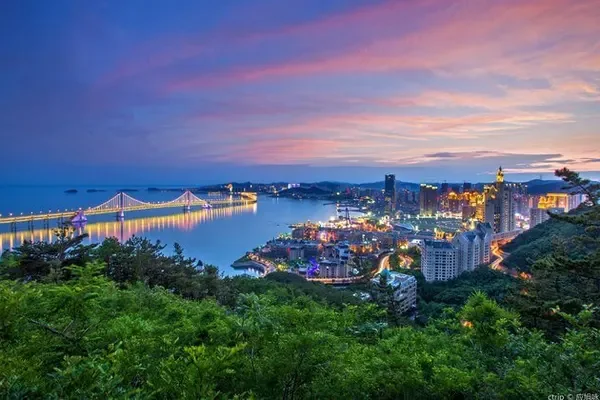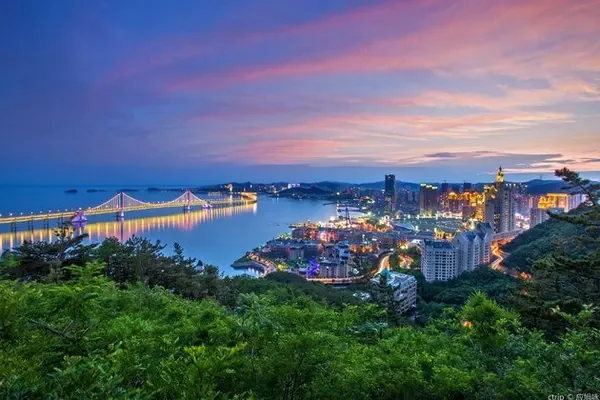Looking back on history, the development and changes of the Qing Dynasty from weak to strong, from prosperity to decline, witnessed the rise of 14 mausoleums in the Qingxi Mausoleum during the precarious 289 years. Past and future, it seems that the veil of the Qing Dynasty that hangs over the Qingxi Mausoleum is gradually lifted by us.
The West Qing Mausoleum is the mausoleum of four emperors since Yongzheng in the Qing Dynasty. It is surrounded by the mountainous Yongning Mountain in the north and the winding Yishui River in the south.
I remember that the ticket was still 120 yuan when I came to Qingxiling last time, but now the ticket price has dropped to 108 yuan in peak season and 80 yuan in off-season, so I brought two or three friends to Qingxiling again in this early spring season. Here is a reminder to the student party: Bring your student ID to get half-price, only 40 yuan!
We started from downtown Baoding, changed trains twice, and finally took the 981 bus to Yixian Station. In fact, the 681 bus can also get there, but it takes an hour longer than the 981 bus.
After arriving at Yixian Station, transfer to No. 9 bus and go straight to Qingxiling. No. 9 bus is specially prepared for tourists of Qingxiling.
Standing in the Qingxi Mausoleum, I can feel the century-old history, and this seemingly gorgeous mausoleum has finally become a trace in the long river of history. Every building in the Western Qing Mausoleum tells the story of the prosperity and decline of the Qing Dynasty for a hundred years, and they are trying their best to show the world the footprints of the last royal mausoleum left by the Qing Dynasty.
I remembered that the one who chose the mausoleum said to Emperor Yongzheng: "The area where the universe gathers beauty, the place where yin and yang circle, the dragon's cave, sand and water, there is no beauty. The situation is rational, and the auspicious people are ready."
After purchasing the tickets in the comprehensive service area, we took the bus to the first stop - Tailing. Tailing is the first tomb among the western Qing tombs and the largest. With a Shinto as the central axis of the Tailing Mausoleum, there are many single buildings such as the stone archway, the Dahongmen, the stele pavilion of Shengde and Shengong, and the stone statues in the north and south. The mottled and wide stone brick roads, the glazed tiles still glowing with golden light, and the stone lions sitting with their heads held high all tell the prosperity and glory of the country during the Yongzheng period. Climbing up the steps, one can't help admiring the architectural art at that time.
After visiting for about an hour, I then transferred to Chongling by CMB. Chongling is the tomb of Emperor Guangxu and Empress Dowager Longyu, and it is also the last feudal emperor's tomb in China. The construction scale of Chongling Mausoleum is smaller than that of Tailing Mausoleum, but it is a mausoleum project boasting dynasties, which absorbs the essence of modern construction technology, and has complete drainage and ventilation equipment. There are majestic and majestic city towers, precious silver pine and podocarpus pine on the outside, tall and strong corridors and heavy stone gates inside. The moss on the corridor deepens the sense of age of the mausoleum, which makes people think of the complicated and confusing cause of Guangxu's death. Through the ancient city walls, it seems to see the turmoil of that era.
After recalling the historical pictures, I came to Yongfu Temple unknowingly. Yongfu Temple is the only royal temple preserved among the royal tombs of the Ming and Qing dynasties. The Qing government respected Lamaism and designated it as the state religion. The purpose was to use Lamaism to rule all ethnic groups and maintain the unity and consolidation of the multi-ethnic country. The pattern of the whole temple is divided into east, middle and west roads. The building covered with yellow glazed tiles in the middle is used to enshrine Buddha statues, and the buildings with gray tile roofs on both sides are monk houses.
It can be seen from this pattern that the rulers of the Qing Dynasty attached great importance to religion. Closing my eyes and feeling, I seem to hear the ancient Sanskrit sound that reaches directly to the soul, the vigorous and heavy ringing of the bell, and bursts of fragrance from the incense burner, making people immersed in the meaning of Buddhist culture.
After visiting Yongfu Temple for a long time, I returned to the service area of Tailing Mausoleum, changed to Route 2, and arrived at Changxi Mausoleum. Changxi Mausoleum is a mausoleum of empresses, in which Empress Xiao and Rui of Emperor Jiaqing are buried. The architectural style of Changxi Mausoleum is relatively simple, even if it is simple, it cannot conceal its noble and exquisite atmosphere. The colorful paintings of the mausoleum are bright in color, and after years of erosion, they can't hide their fine workmanship. There is a Yudai River between the back of the Longen Hall and the three gates.
There are three bridges across the river. Such an exquisite pattern is unique in the construction of the Queen's Mausoleum. When you come here, the most important thing is to experience the echoing wall and the echoing stone. The echoing effect and preservation state are almost comparable to the echoing wall in the Temple of Heaven in Beijing.
After playing in front of the Echo Wall for a long time, I left reluctantly when I was tired, and finally came to Muling. Muling is the mausoleum of Emperor Daoguang, the eighth emperor of the Qing Dynasty. Around Muling, there are towering green mountains, and when the mist rises, it seems like a fairyland on earth. The nanmu carvings in Muling are a must. Thousands of nanmu carved dragons are decorated with gorgeous and magnificent. I can't help applauding the patience and superb skills of the craftsmen at that time.
In addition to some nostalgic scenic spots, for Chinese-style tourism, the criterion for judging whether a scenic spot is worth visiting is not only whether the scenery of the place is enough to attract you, but also an important criterion for judging whether it is the unique local food. , Most people who love to travel will go out with their extremely unsatisfied Chinese stomach before going out.
We came to Qing Xiling to eat authentic Manchu court dishes. So we chose the nearby Xinggong Hotel, so that we can also experience the emperor's treatment.
I am very pleased to focus on these few dishes.
Pine Nut Tripe
Fresh large pine nuts, meat granules and meat skin are very chewy and full of meaty aroma, which satisfies my taste buds.
steamed bear paw
Did you really think they were bear paws? It’s against the law, of course not. It’s made of tofu. It’s a surprise to me. It’s not only made of tofu, but also mushrooms, fungus, etc. The stuffing made with precious stuffing, and topped with the delicious and bright soup, take a bite, it's good, it's good. I am very satisfied.
Cucumber
This is the first time I have eaten such a beautiful cucumber. The scallops in it are the finishing touch. Some dishes are hard to tell, but they are good anyway, but they are difficult to break, and I can’t use chopsticks.
No matter how beautiful the scenic spots are, it would be a pity not to be accompanied by delicious food, so I have no regrets about this journey.
Here is one more word, Yi County still has a lot of beautiful scenery, if you have enough time, it is also a good choice to take a tour around.
Famous tourist attractions include Langya Mountain, Yishui Lake, Yunmeng Mountain and so on.
We went there on the same day and returned on the same day, so we wandered slowly until the moment when the sun was about to set.
Walking slowly in the alley, I feel the unusual and unobtainable calm atmosphere.
As the sun sets, watching the last ray of golden sunlight shine on every ancient relic here, maybe the sun in early spring was accidentally knocked over by a naive child like a wine bottle, not only mottled the ancient city wall , also slowly trickled into my heart.


